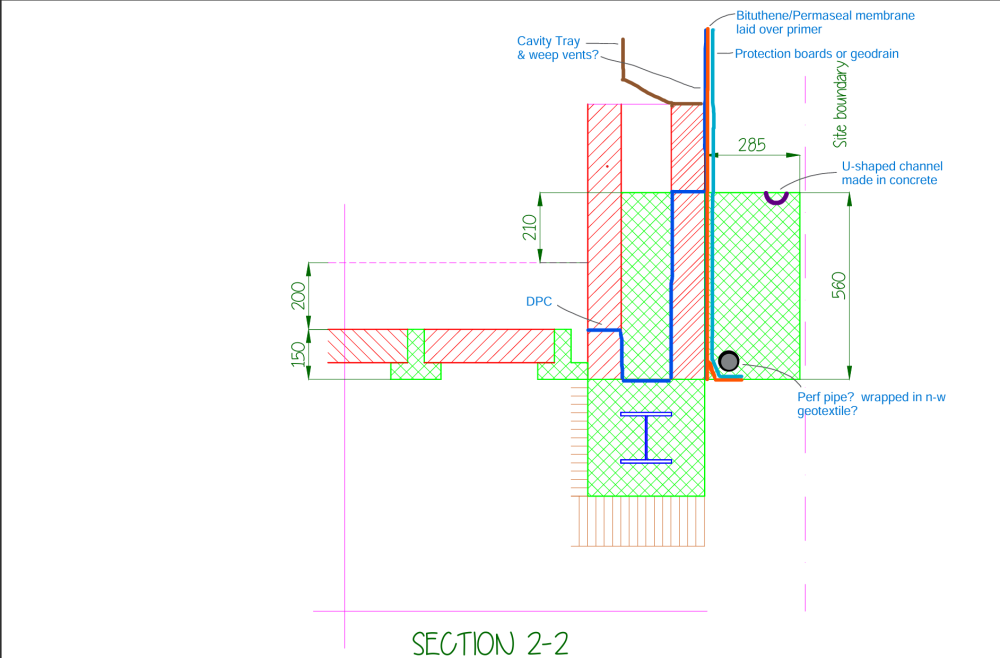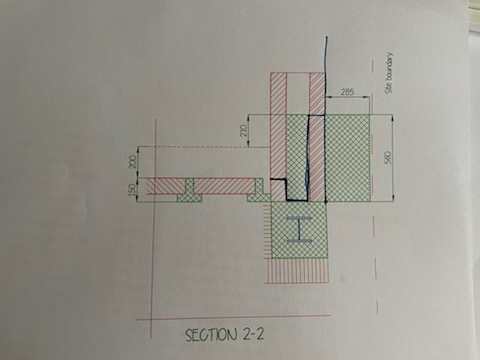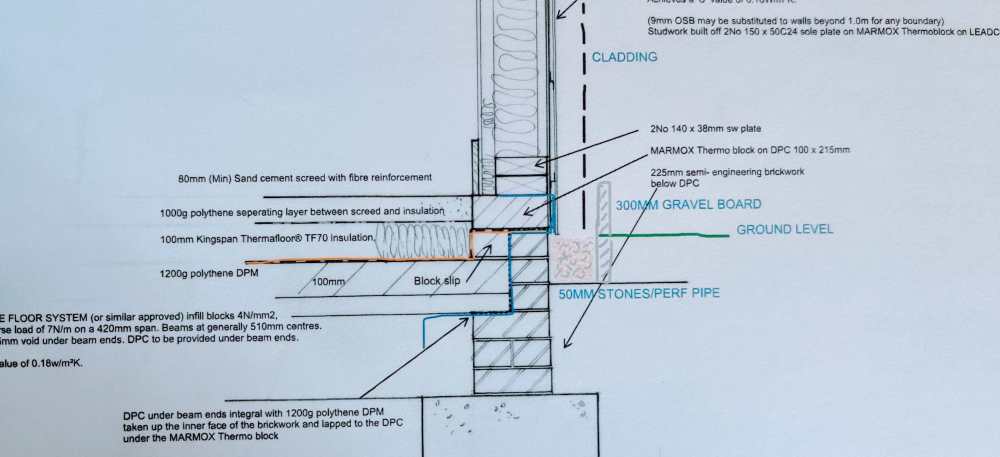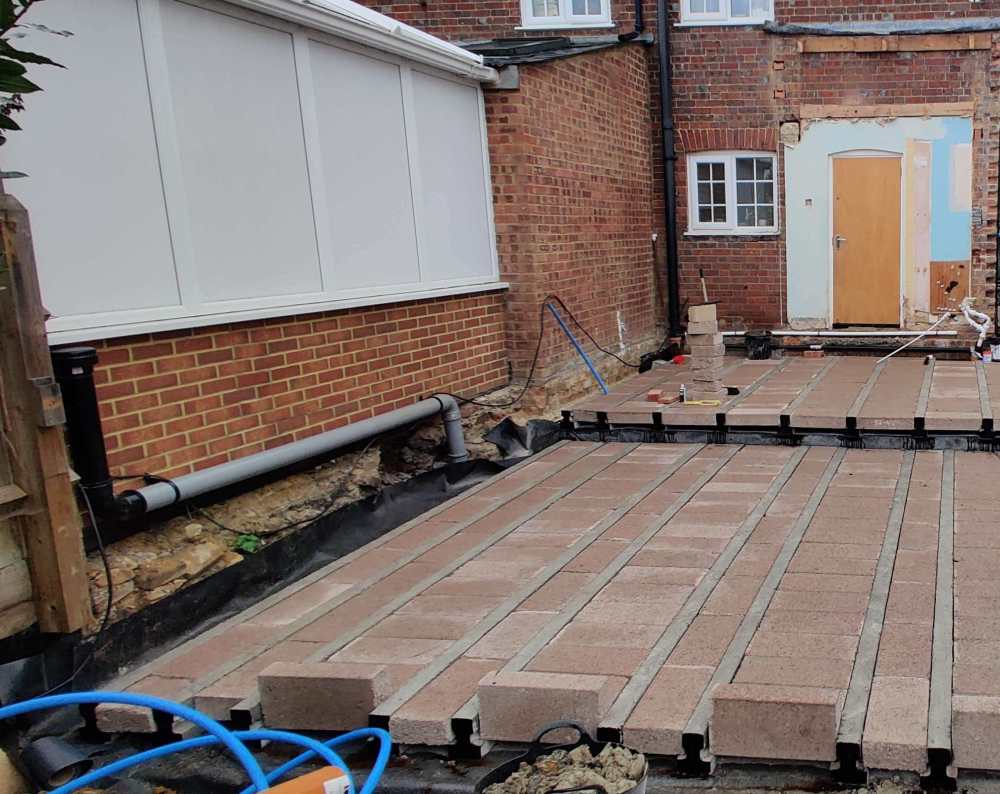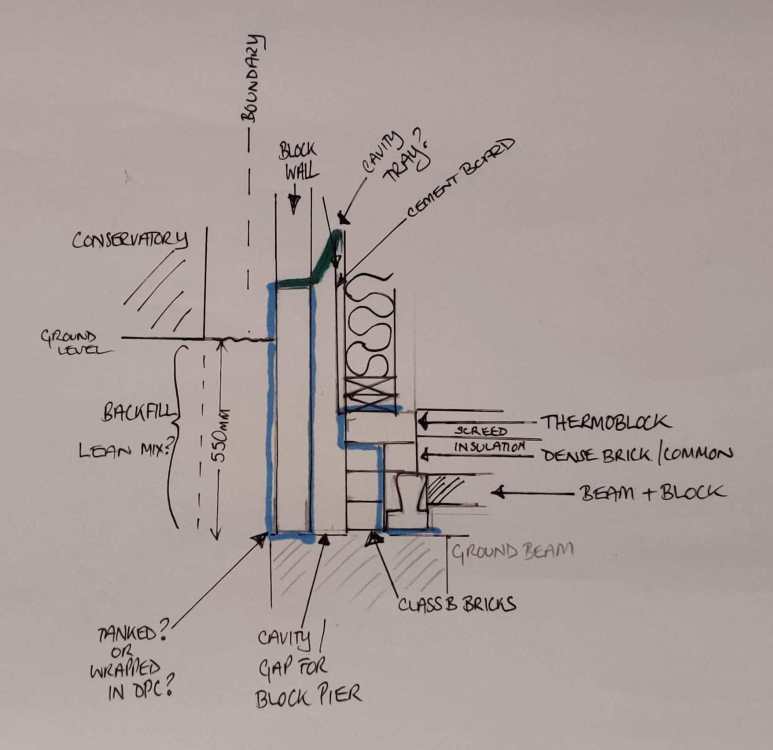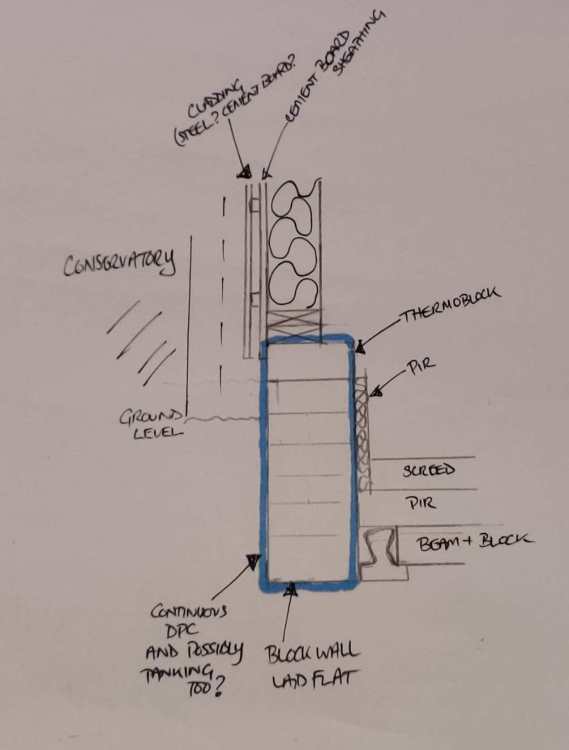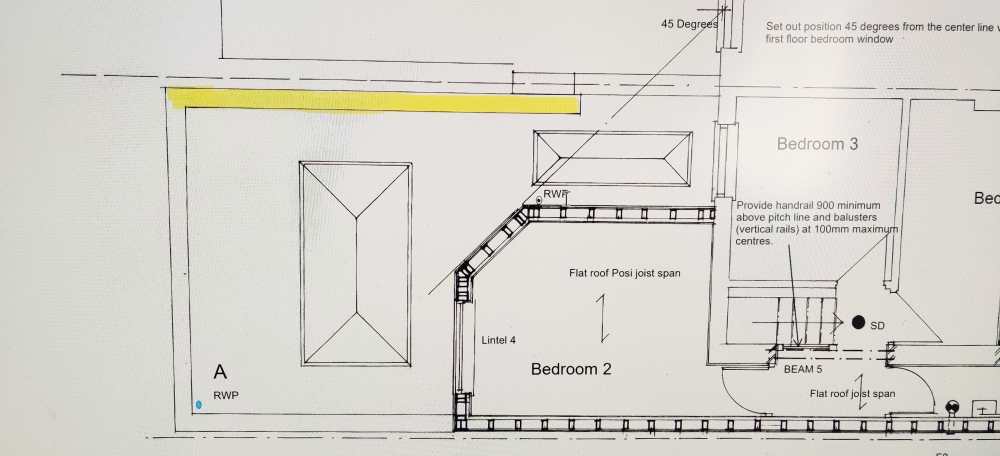
AdTee
Members-
Posts
32 -
Joined
-
Last visited
Personal Information
-
Location
South East
Recent Profile Visitors
The recent visitors block is disabled and is not being shown to other users.
AdTee's Achievements

Member (3/5)
4
Reputation
-
Thanks @sgt_woulds, and apologies for the delay in replying. We've spoken to Klasse who say their board can be directly mounted to the timber frame, but as you mentioned preventing moisture build-up could be tricky. I'll look into woodfibre although with aluminium cladding it would need a ventilated cavity behind it, so I'm not sure if that would be possible.
-
I'm currently in the middle of timber framing my DIY extension. One long flank is right on the boundary, so non-combustible cement board was specified by the architect as sheathing, but this is causing me a few headaches. Architect spec: Insulated PB Vapour Barrier Timber Frame (insulation between studs) Cement Board (direct to frame) - RCM Y Wall Battens Aluminium Cladding Problem is that Y Wall and all other cement boards that I've found also specify a ventilated cavity between the board and the timber frame. I've spent ages trying to find cement boards with racking resistance comparable or better than OSB, but now I'm worried that it will be compromised if not planked directly on the studwork. Not to mention that I'm having to add a second cavity which means I'd probably need another housewrap layer (and possibly 9mm osb) between the battens and the frame. Of all the boards, STS is coming out the cheapest, and Klasse C-Board seems to have the best spec for racking. Has anyone had any similar experiences? Thanks
-
Anyone used pitched roof windows on a flat roof?
AdTee replied to AdTee's topic in Skylights & Roof Windows
Useful advice, thanks very much. -
Yep, will do. I'll get chance to fiddle with it tomorrow. Mass-concrete is the solution the SE came up with. He just left it to me to figure out the waterproofing. The BCO suggested bituthene, hence going with the Permaseal. For now, the green cross-hatching is concrete, the red vertical dashed line is the conservatory (not the boundary as labelled). The two red columns are blockwork, forming the base of a new wall - the cavity, up to the height of the conservatory is also to be filled with concrete. The steel encased in concrete is a ground beam foundation. The boundary line is approx half way between the conservatory and my new block wall. The pipe in the photos sits against the conservatory, pretty much along the boundary, and possibly a little over it. We've now started the blockwork, with the exterior skin up to 600mm. I'm hoping to get the waterproofing in this weekend.
-
I'm sending out for posi joist quotes and have decided for various reasons that I'd rather have several smaller rooflights than the large one originally spec'd (approx 3m x 1.6m). I've looked at many options including standard opening and non-opening flat roof windows, and I've now started looking into using pitched rooflights on a sloping upstand. I asked Keylite who said 'A standard centre pivot roof window can be fitted to site formed, provided the site formed upstand is fabricated at a 15° fall across the roof window.' Does anyone have any experiences or thoughts on this idea, please? Thanks
-
Thanks very much for taking the time to reply, Redbeard. Yeah, it's a bit of a messy situation. The conservatory needed planning (outside of permitted dev due to length) and building regs (opened into main house and kitchen inside it) which it doesn't have, neither does it have a build-over agreement with the water co. The neighbour has inspected from my side and isn't concerned about any of it, including their footings. The retaining concrete fill will be more of a rough triangular shape from the bottom corner my side, to around 100-150 mm from the top corner their side, blanketing the spoil. Regarding it being pointless, I was also concerned that it would weaken the concrete retainer by having the perf pipe and loose fill at the bottom of it. You're so right about the pipe being the wrong conduit for any 'fall out'. I could add it to my drainage system but it feels like I could end up making the whole situation worse in the event of any problems. The BCO pointed out to me last week, that there were other options available for their vent, but they chose to stick with that one, so any future leaks would need to be dealt with via the conservatory floor. I've ordered the Permaseal membrane and primer for my blockwork, and will either add some kind of jablite sheets or a bitumenous protection board in there to prevent damage to the membrane. I'm also toying with the idea of blackjacking the surface of the concrete infill but whether that'll hold over time I'm not sure.
-
Hi all, Some of you may remember my posts from late last year where I had to pause my extension to get an SE to detail how to prevent my neighbour's conservatory from sliding into my extension... https://forum.buildhub.org.uk/topic/40498-i-am-soooooo-stuck/ It's been a tough 8 months with 2 sewage leaks and a water leak all beneath the neighbour's conservatory pouring 'fluids' all over my foundations (not helped by their lack of build-over agreement with the water co.).Since then, I've been researching how to waterproof the lower part of the wall (blockwork cavity wall with concrete infill), and think I'll definitely be using a bitumen self-adheseive layer over a primer. BCO suggested Bituthene, but Permaseal looks good too and is slightly cheaper. Question is, as it's only a 285mm gap between the two buildings, direct rainfall should be minimal, so do I need to worry about hydrostatic pressure, or even their vent pipe leaking sewage (as it's the head of a 5-cottage sewer run)? I've considered if there's any way to fit a dimpled drainage sheet between the waterproof layer and the concrete, but that would need something to drain into, and a perf pipe underneath all that concrete would be pointless (unless perhaps I put a layer of EPS between the permaseal and the Geodrain dimpled mat creating a cavity below for the perf pipe?). Would be great to hear your opinions on this one, please! Thanks
-
Thanks, that was my thinking👍. I may go for a skin of insulated plasterboard, or possibly even a slim stud wall .
-
Hi all, Following your help a couple of months back, I thought I'd update you on where I'm currently at with this! After myriad delays, the SE finally produced his solution last week: The wall in question will switch from timber frame to brick and block cavity, which will span the width of the ground beam. The gap between the new wall and the neighbour's conservatory (285mm in width) will be filled with concrete, blanketing the spill that is there (I'll remove the loose debris and cut it back where poss) up to the bottom of the conservatory (560mm height). The concrete will be laid with a fall away from my wall, and a channel of some kind will be formed to take water down towards the garden. The SE spec'd the wall cavity to also be filled with concrete up to the same height. He didn't make any suggestion for waterproofing, referring me to the BCO, who suggested using something like bituthene, and drew her idea (second pic) onto the engineer's drawing. Neither of them think that insulation will be necessary due to the mass of the wall, although personally I think I should go belt and braces and insulate somehow. I know it's far from ideal, but I think I have little alternative. I'd be really grateful for any ideas for waterproofing and insulation that you may have, please. If I can just get this wall design finalised and built in the next week or so, I'll be happy. I'm going to leave the timber framing until the spring when I can get a good run at it. Mahoosive thanks! 6154-SK02 Section 2-2.pdf
-
Raising the floor had crossed my mind. Russell, the steps down are a mix of practical and asthetic. We have a step down from the the old cottage of 175mm to increase the ceiling height from 2m (would've been a lower ceiling than the cottage ceilings due to increased joist depth), and then another step of 250 to create a split level kitchen/diner. This will still leave a good step or two down into the garden from FFL due to the sloping site.
-
I've emailed the SE, fingers crossed he can fit me in and can design a working solution. Love your ethos, G&J! Will certainly push for it if the SE can deliver in time. Its not even an old wall, just rubble they threw up against the fence. I would say probably 150-250mm looks like original ground, but it's scrappy at best. Its their AAV. We've made a new connection to the main sewer (we were connected to a shared run via the pipe the that the grey 110mm finally connects into), and discovered on excavation of our unused soil vent pipe (against back wall of house) that they had tapped into it when they had their extension built. We're removing our SVP and the AAV was the choice they made for venting rather than doing any major works. They can access the valve via a small panel in the return of the fence. Yep, you're right, it should've been sorted earlier. I just took my eye off the ball on that one as so many problems kept arising. Only yesterday did the water company finally sleeve holes in the neighbour's sewer run to prevent sewage seaping out and under my foundations. Formwork would certainly be a good way of shutting away the problem. I'd be a bit nervous about any further excavation so if would be great if it could be achieved without much of that! Russell, I hadn't considered ICF before. Will look into it.
-
Thank you everyone for your thoughts - it really makes a difference when it feels like you're just running aroud in the dark. Taking this back to the SE is good advice that I shall follow. The gravel board retainer on the wall detail is a for small section on the other flank. Unfortunately the neighbour's conservatory builders had piled the back fill up against the fence that was there. Shame they didn't put a proper retainer in at the time. The architectural tech suggested adding piers to a 100mm block wall, although they would need to be internal and this would be tricky with the timber frame inner wall. Flank foundations are 152x152 uc23 steels in concrete making a total groundbeam size of 352x352, and sat on 3 pads along that side, 2m deep at the garden end due to a tree, then 1.2m, and 1m as they move toward the house. When I mentioned my concerns of the proximity of the conservatory to the SE last year, he said that a lightweight masonry wall would be ok, so hopefully he can come up with something that works. We had so much trouble below ground with historic footings, sewage leaks from the neighbours, and 5 different victorian drain runs, that sadly I wasn't focussed on this impending issue. We have full planning. On the last visit from the private BCO, she said she was happy for block on that wall as long as it was brought up in render as it was built. She said it would be like building against a garden wall (my mind was set racing around moisture, ventilation etc at this point!). Fortunately, I'm not particularly concerned about the neightbour in question as I've just dicovered they've built the darn conservatory without regs anyway (it has become their kitchen extension!). In case of having to shelve the project for winter (shudders at the thought of zero insulation, and being without central heating as the boiler was in the old demolished kitchen!), would the b&b floor need protecting from the elements? Thanks.
-
Ah I think I see what you mean, but the it's only the one wall alongside the conservatory that's the issue really, as the all the gardens slope down that way. It's a combination of the conservatory sat on made-up ground/rubble fill, and our side flattened out into two levels.
-
Hi folks, I really need some help on this one please! I've started building and I'm not sure how to progress. Apologies that I've posted recently on this subject (without reply, unfortunately) - I can't work out how to delete it. I wanted to share a few pics/ updated drawings in the hope that it might spark an idea or two. So, It's an end terrace, DIY stick-build timber frame extension, building off of a groundbeam (steels encased in concrete). Wall make-up to be as shown in first pic. THE BIG SNAG!... One side wall will sit 100mm from boundary with neighbour and 300mm from their conservatory. Due to a sloping site, finished floor level of half the extension will be 225mm below the bottom of neighbour's conservatory, (and bottom of the conservatory to base of my wall will be 550mm) - see pic/photo 2. Meaning, I need to back fill behind my new wall up to the bottom of their conservatory (fill of approx 200mm wide by 550mm high). I need an alternative to my standard TF at this point but can't fathom it out. The architectural tech had a look this week but isn't sure himself - we bashed out an idea but it's far from perfect, and I'm not even sure it will work (see pic 3). A builder friend (who admits to having little TF experience) came up with another idea (pic 4) but I'm not sure if this will work either. MAIN CONCERNS Drainage/Tanking/DPC's/moisture control/breathability, standing up a TF wall pre-clad and sheathed in cement board (weight/ & this wall also needs to be sealed up against the neighbour's rear brick extension which sits astride the boundary), and I only have the 300mm gap between their conservatory and my wall to get to it) I'm desperate for a solution as I need to start getting this frame built before the weather turns. Any help to get me on my way will be massively appreciated! Thanks in advance Ad
-


